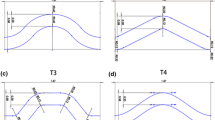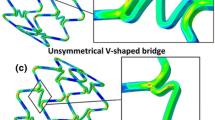Abstract
Coronary stents are tubular type scaffolds that are deployed, using an inflatable balloon on a catheter, most commonly to recover the lumen size of narrowed (diseased) arterial segments. A common differentiating factor between the numerous stents used in clinical practice today is their geometric design. An ideal stent should have high radial strength to provide good arterial support post-expansion, have high flexibility for easy manoeuvrability during deployment, cause minimal injury to the artery when being expanded and, for drug eluting stents, should provide adequate drug in the arterial tissue. Often, with any stent design, these objectives are in competition such that improvement in one objective is a result of trade-off in others. This study proposes a technique to parameterize stent geometry, by varying the shape of circumferential rings and the links, and assess performance by modelling the processes of balloon expansion and drug diffusion. Finite element analysis is used to expand each stent (through balloon inflation) into contact with a representative diseased coronary artery model, followed by a drug release simulation. Also, a separate model is constructed to measure stent flexibility. Since the computational simulation time for each design is very high (approximately 24 h), a Gaussian process modelling approach is used to analyse the design space corresponding to the proposed parameterization. Four objectives to assess recoil, stress distribution, drug distribution and flexibility are set up to perform optimization studies. In particular, single objective constrained optimization problems are set up to improve the design relative to the baseline geometry—i.e. to improve one objective without compromising the others. Improvements of 8, 6 and 15% are obtained individually for stress, drug and flexibility metrics, respectively. The relative influence of the design features on each objective is quantified in terms of main effects, thereby suggesting the design features which could be altered to improve stent performance. In particular, it is shown that large values of strut width combined with smaller axial lengths of circumferential rings are optimal in terms of minimizing average stresses and maximizing drug delivery. Furthermore, it is shown that a larger amplitude of the links with minimum curved regions is desirable for improved flexibility, average stresses and drug delivery.
Similar content being viewed by others
References
Atherton M, Bates R (2006) Searching for improvement. In: Bryant JA, Atherton MA, Collins MW (eds) Information transfer in biological systems, design in nature series, vol 2. WIT Press, Southampton, pp 345–379. ISBN 1853128538
Bedoya J, Meyer C, Timmins L, Moreno M, Moore J Jr (2006) Effects of stent design parameters on normal artery wall mechanics. J Biomech Eng 128: 757–765
Blouza A, Dumas L, M’Baye I (2008) Multiobjective optimization of a stent in a fluid-structure context. In: Proceedings of the 2008 GECCO conference companion on Genetic and evolutionary computation, pp 2055–2060
Carter AJ, Laird JR, Farb A, Kufs W, Wortham DC, Virmani R (1994) Morphologic characteristics of lesion formation and time course of smooth muscle cell proliferation in a porcine proliferative restenosis model. J Am Coll Cardiol 24: 1398–1405
Contiliano J, Zhang Q (2009) Method of manufacturing a polymeric stent having a circumferential ring configuration. WO Patent WO/2009/121048
Cordis Corporation (2010) Insrtuctions for use: CYPHER sirolimus-eluting coronary stent on RAPTOR over-the-wire delivery system. Johnson & Johnson company, Warren/Bridgewater Campus, 12th edn, http://www.cordislabeling.com , last accessed 20th May, 2010, 1913 hrs
Crank J (1979) The mathematics of diffusion. Oxford University Press, USA
Dassault Syst́emes (2009) Abaqus 6.9.1 user manual. Dassault Systèmes Simulia Corp
De Beule M (2008) Finite element stent design. PhD thesis, University of Gent
De Beule M, Van Impe R, Verhegghe B, Segers P, Verdonck P (2006) Finite element analysis and stent design: reduction of dogboning. Technol Health Care 14(4): 233–241
De Beule M, Mortier P, Carlier S, Verhegghe B, Van Impe R, Verdonck P (2008) Realistic finite element-based stent design: the impact of balloon folding. J Biomech 41(2): 383–389
Engineers Hand Book (2010) http://www.engineershandbook.com; last accessed 02 May, 2010
Farb A, Sangiorgi G, Carter AJ, Walley VM, Edwards WD, Schwartz RS, Virmani R (1999) Pathology of acute and chronic coronary stenting in humans. Circulation 99: 44–52
Feenstra P, Taylor C (2009) Drug transport in artery walls: a sequential porohyperelastic-transport approach. Comput Meth Biomech Biomed Eng 12(3): 263–276
Forrester AIJ, Sóbester A, Keane AJ (2008) Engineering design via surrogate modelling: a practical guide. Wiley, Chichester, p 240. ISBN 978-0-470-06068-1
Gervaso F, Capelli C, Petrini L, Lattanzio S, Di Virgilio L, Migliavacca F (2008) On the effects of different strategies in modelling balloon-expandable stenting by means of finite element method. J Biomech 41(6): 1206–1212
Hara H, Nakamura M, Schwartz R (2006) Role of stent design and coatings on restenosis and thrombosis. Adv Drug Deliv Rev 58: 377–386
Hicks R, Henne P (1978) Wing design by numerical optimization. J Aircr 15(7): 407–412
Hoffmann R, Mintz GS, Mehran R, Kent KM, Pichard AD, Satler LF, Leon MB (1999) Tissue proliferation within and surrounding palmaz-schatz stents is dependent on the aggressiveness of stent implanation technique. Am J Cardiol 83: 1170–1174
Holzapfel G, Sommer G, Regitnig P (2004) Anisotropic mechanical properties of tissue components in human atherosclerotic plaques. J Biomech Eng 126(5): 657–665
Holzapfel G, Sommer G, Gasser C, Regitnig P (2005a) Determination of layer-specific mechanical properties of human coronary arteries with nonatherosclerotic intimal thickening and related constitutive modeling. Am J Physiol Heart Circ Physiol 289(5): H2048– H2058
Holzapfel GA, Stadler M, Gasser T (2005) Changes in the mechanical environment of stenotic arteries during interaction with stents: computational assessment of parametric stent designs. J Biomech Eng 127: 166–180
Hose D, Narracott A, Griffiths B, Mahmood S, Gunn J, Sweeney D, Lawford P (2004) A thermal analogy for modelling drug elution from cardiovascular stents. Comput Meth Biomech Biomed Eng 7(5): 257–264
Jones D, Schonlau M, Welch W (1998) Efficient global optimization of expensive black-box functions. J Global Optim 13(4): 455– 492
Jua F, Xiaa Z, Zhoub C (2008) Repeated unit cell (RUC) approach for pure bending analysis of coronary stents. Comput Meth Biomech Biomed Eng 11(4): 419–431
Kastrati A, Mehilli J, Dirschinger J, Dotzer F, Schuhlen H, Neumann F, Fleckenstein M, Pfafferott C, Seyfarth M, Schomig A (2001) Intracoronary stenting and angiographic results: strut thickness effect on restenosis outcome (isar-stereo) trial. Circulation 103: 2816–2821
Keane A, Nair P (2005) Computational approaches for aerospace design. The pursuit of excellence. Wiley, Chichester
Kiousis D, Gasser T, Holzapfel G (2007) A numerical model to study the interaction of vascular stents with human atherosclerotic lesions. Ann Biomed Eng 35(11): 1857–1869
Knig A, Schiele TM, Rieber J, Theisen K, Mudra H, Klauss V (2002) Influence of stent design and deployment technique on neointima formation and vascular remodeling. Z Kardiol 91: 98–102
Kock S, Nygaard J, Eldrup N, Frund E, Klærke A, Paaske W, Falk E, Yong Kim W (2008) Mechanical stresses in carotid plaques using MRI-based fluid–structure interaction models. J Biomech 41(8): 1651–1658
Kolachalama V, Bressloff N, Nair P (2007a) Mining data from hemodynamic simulations via Bayesian emulation. Biomed Eng Online 6(1): 47
Kolachalama V, Bressloff N, Nair P, Shearman C (2007b) Predictive haemodynamics in a one-dimensional human carotid artery bifurcation. Part I: application to stent design. IEEE Trans Biomed Eng 54(5): 802–812
Kolachalama V, Tzafriri A, Arifin D, Edelman E (2009) Luminal flow patterns dictate arterial drug deposition in stent-based delivery. J Controlled Release 133(1): 24–30
Kornowski R, Hong MK, Tio FO, Bramwell O, Wu H, Leon MB (1998) In-stent restenosis: contributions of inflammatory responses and arterial injury to neointimal hyperplasia. J Am Coll Cardiol 31: 224–230
Ku D (1997) Blood flow in arteries. Annu Rev Fluid Mech 29: 399–434
Ku D, Zarins C, Giddens D, Glagov S (1985) Pulsatile flow and atherosclerosis in the human carotid bifurcation: positve correlation between plaque localization and low and oscillating shear stress. Arteriosclerosis 5: 292–302
Li N, Gu Y (2005) Parametric design analysis and shape optimization of coronary arteries stent structure. In: Proceedings of 6th world congresses of structural and multidisciplinary optimization, Rio de Janeiro, 30 May–03 June, 2005, Brazil
Li N, Zhanga H, Ouyang H (2009) Shape optimization of coronary artery stent based on a parametric model. Finite Elem Anal Des 45: 468–475
McGarry J, O’Donnell B, McHugh P, McGarry J (2004) Analysis of the mechanical performance of a cardiovascular stent design based on micromechanical modelling. Comput Mater Sci 31(3–4): 421–438
Moore J Jr, Xu C, Glagov S, Zarins C, Ku D (1994) Fluid wall shear stress measurements in a model of the human abdominal aorta: oscillatory behavior and relationship to atherosclerosis. Atherosclerosis 110(2): 225–240
Mori K, Saito T (2005) Effects of stent structure on stent flexibility measurements. Ann Biomed Eng 33(6): 733–742
Morton AC, Crossman D, Gunn J (2004) The influence of physical stent parameters upon restenosis. Pathol Biol 52: 196–205
Murphy B, Savage P, McHugh P, Quinn D (2003) The stress–strain behavior of coronary stent struts is size dependent. Ann Biomed Eng 31(6): 686–691
Pache J, Kastrati A, Mehilli J, Schuhlen H, Dotzer F, Hausleiter J, Fleckenstein M, Neumann F, Sattelberger U, Schmitt C, Muller M, Dirschinger J, Schomig A (2003) Intracoronary stenting and angiographic results: strut thickness effect on restenosis outcome (isar-stereo-2) trial. J Am Coll Cardiol 41(8): 1283–1288
Pericevic I, Lally C, Toner D, Kelly D (2009) The influence of plaque composition on underlying arterial wall stress during stent expansion: the case for lesion-specific stents. Med Eng Phys 31(4): 428–433
Petrini L, Migliavacca F, Auricchio F, Dubini G (2004) Numerical investigation of the intravascular coronary stent flexibility. J Biomech 37(4): 495–501
Schwartz RS, Huber KC, Murphy JG, Edwards WD, Camrud AR, Vlietstra RE, Holmes DR (1992) Restenosis and the proportional neointimal response to coronary artery injury: results in a porcine model. J Am Coll Cardiol 19: 267–274
Serruys P (1997) Handbook of coronary stents, 4th edn. Martin Dunitz Publishers, London
Sobol I (2001) Global sensitivity indices for nonlinear mathematical models and their Monte Carlo estimates. Math Comput Simul 55(1–3): 271–280
Statnikov R, Matusov J (2002) Multicriteria analysis in engineering: using the PSI method with MOVI 1.0. Kluwer, Dordrecht
Timmins L, Moreno M, Meyer C, Criscione J, Rachev A, Moore J (2007) Stented artery biomechanics and device design optimization. Med Biol Eng Comput 45(5): 505–513
Wang W, Liang D, Yang D, Qi M (2006) Analysis of the transient expansion behavior and design optimization of coronary stents by finite element method. J Biomech 39(1): 21–32
Wentzel J, Krams R, Schuurbiers J, Oomen J, Kloet J, Giessen W, Serruys P, Slager C (2001) Relationship between neointimal thickness and shear stress after wallstent implantation in human coronary arteries. Circulation 103: 1740–1745
Wong H, Cho K, Tang W (2009) Bending of a stented atherosclerotic artery. In: Proceedings of the COMSOL conference 2009 Boston
Wu W, Yang D, Qi M, Wang W (2007) An FEA method to study flexibility of expanded coronary stents. J Mater Process Technol 184(1–3): 447–450
Wu W, Petrini L, Gastaldi D, Villa T, Vedani M, Lesma E, Previtali B, Migliavacca F (2010) Finite element shape optimization for biodegradable magnesium alloy stents. Ann Biomed Eng 38(9): 2829–2840
Zhou J, Tits A, Lawrence C (1998) User’s guide for FFSQP version 3.7: A FORTRAN code for solving constrained nonlinear (minimax) optimization problems, generating iterates satisfying all inequality and linear constraints. Institute for Systems Research, University of Maryland, College Park, MD
Zunino P, D’Angelo C, Petrini L, Vergara C, Capelli C, Migliavacca F (2009) Numerical simulation of drug eluting coronary stents: mechanics, fluid dynamics and drug release. Comput Meth Appl Mech Eng 198(45–46): 3633–3644
Author information
Authors and Affiliations
Corresponding author
Rights and permissions
About this article
Cite this article
Pant, S., Bressloff, N.W. & Limbert, G. Geometry parameterization and multidisciplinary constrained optimization of coronary stents. Biomech Model Mechanobiol 11, 61–82 (2012). https://doi.org/10.1007/s10237-011-0293-3
Received:
Accepted:
Published:
Issue Date:
DOI: https://doi.org/10.1007/s10237-011-0293-3




